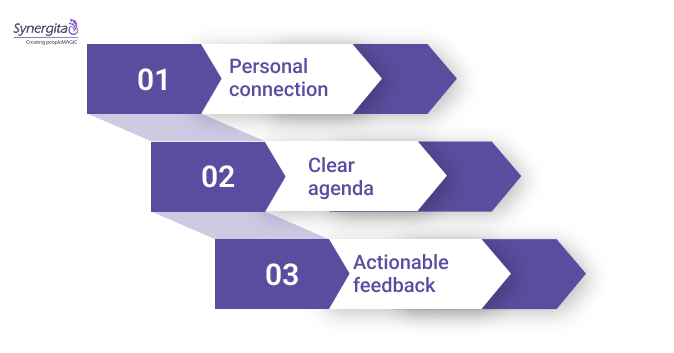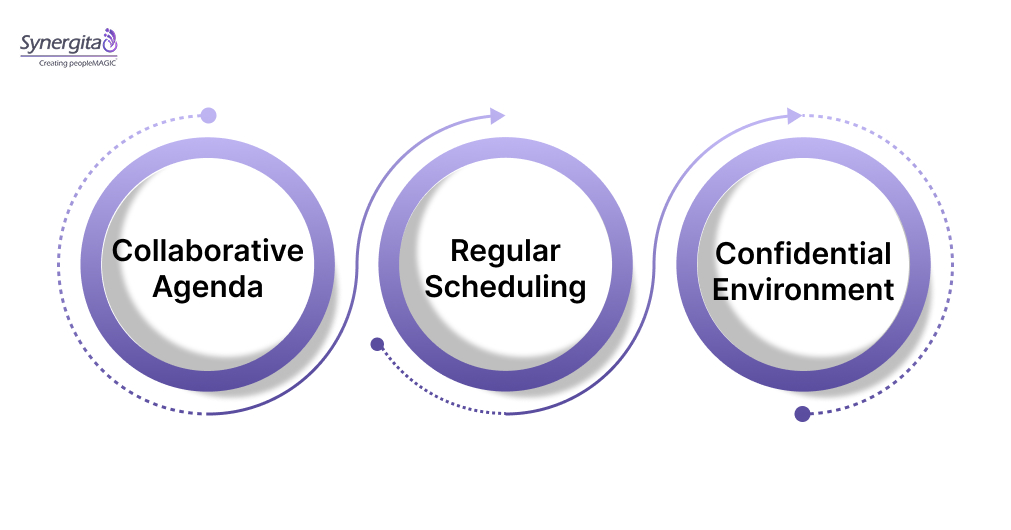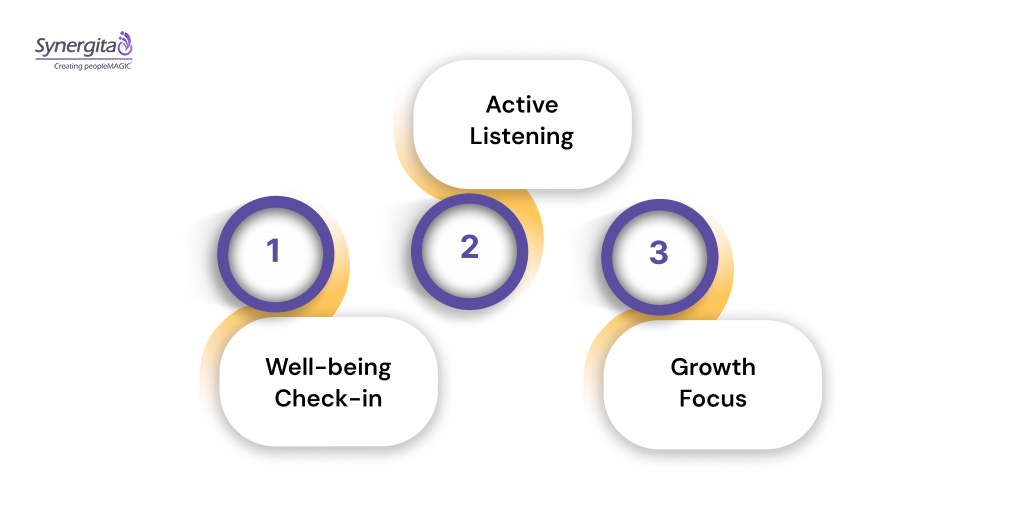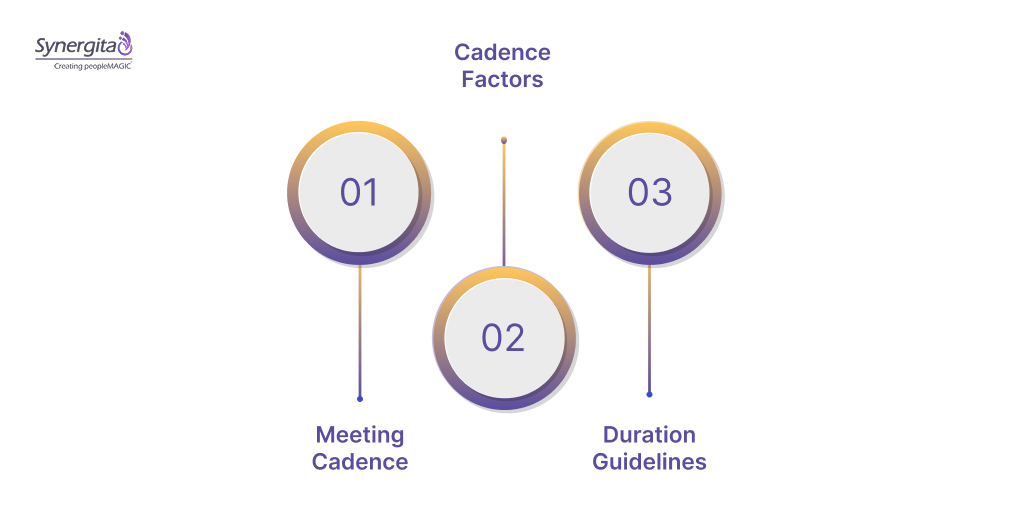1-2-1 meetings are key to building strong, productive relationships with your team.
These conversations provide space for managers and employees to align on goals, address concerns, and foster mutual trust. When done right, 1-2-1 meetings can boost engagement, improve performance, and enhance retention.
But when neglected or mismanaged, they can fall flat, leaving employees feeling unheard.
This article will dive into the importance of 1-2-1 meetings, what makes them effective, and the practical steps for managers to make the most out of these sessions.
Key Takeaways: Do’s and Don’ts of 1-2-1 Meetings
| Do’s | Don’ts |
| Prepare an agenda – Have clear topics to discuss. | Be unprepared – Don’t go in without a plan. |
| Listen carefully – Pay attention and ask questions. | Talk too much – Don’t dominate the conversation. |
| Set goals – Define clear objectives for each meeting. | Focus only on tasks – Don’t make it just a status update. |
| Encourage open dialogue – Let employees share openly. | Dismiss concerns – Don’t ignore or belittle issues. |
| Give constructive feedback – Be specific and helpful. | Give vague feedback – Don’t just point out problems. |
| Create a comfortable environment – Make it easy to talk. | Make it tense – Avoid making the meeting feel formal or uncomfortable. |
| Follow up on action items – Track progress on previous discussions. | Forget to follow up – Don’t leave things unresolved. |
| Be consistent – Hold regular meetings. | Cancel often – Don’t reschedule or cancel regularly. |
What Are 1-2-1 Meetings? Understanding Their Purpose
1-2-1 meetings are scheduled, one-on-one discussions between a manager and an employee. These meetings differ from team discussions or performance reviews by focusing on individual growth, feedback, and personalized communication.
The purpose of these sessions is to create a safe space where employees feel heard and supported.
Key Characteristics of Effective 1-2-1 Meetings

For 1-2-1 meetings to be effective, they must focus on key aspects that go beyond mere task updates:
- Personal connection: Managers should engage in genuine conversations, asking about the employee’s well-being and career aspirations.
- Clear agenda: Both the employee and manager should have a clear idea of the meeting’s purpose and outcomes.
- Actionable feedback: Conversations should be constructive, focusing on solutions and development.
1-2-1 vs. Team Meetings vs. Performance Reviews
1-2-1 meetings differ significantly from other meeting types:
- Team meetings are about group discussion, project status, and company-wide updates. They’re typically less personal and focused on collaboration rather than individual growth.
- Performance reviews are formal evaluations often based on past performance. They’re meant to review how well an employee has met goals, but can sometimes feel more judgmental than supportive.
1-2-1 meetings, on the other hand, are about future development, addressing concerns, and building rapport. There should be a continuous dialogue, rather than a once-a-year performance review.
Want to make your 1-2-1 meetings more impactful? Synergita’s performance and engagement tools can help create a clear framework for these conversations and track progress over time.
The Must-Have Elements of Successful 1-2-1 Meetings

To make the most of 1-2-1 meetings, managers need to ensure they are well-structured and focused on meaningful conversations.
Simply scheduling a meeting isn’t enough; the meeting must be intentional, with clear goals and a balanced approach. Here are the essential components that make these meetings truly effective.
1. Set a Clear, Collaborative Agenda
A well-structured meeting starts with a clear agenda that both the manager and employee can contribute to. This agenda serves as a roadmap, ensuring the meeting stays focused and productive.
- Purpose of Setting a Clear Agenda: A shared agenda ensures that both parties come prepared, addressing key issues and tracking progress.
- Involving Employees in Agenda Creation: Empowering employees to set part of the agenda increases ownership and relevance. It gives them the opportunity to discuss what matters most to them, from career development to project challenges.
- Benefits of Shared Preparation: When employees know what to expect, they feel more engaged and can contribute meaningfully to the discussion.
2. Schedule Regularly and Consistently
Consistency is key to building trust and making 1-2-1 meetings an integral part of the team’s routine.
- Optimal Meeting Frequency Guidelines: While some managers prefer weekly check-ins, others may opt for bi-weekly or monthly sessions, depending on the team’s needs and goals. It’s essential to find a rhythm that works and stick to it.
- Creating a Reliable Routine: By scheduling regular 1-2-1s, employees know that their feedback and development are prioritized. This consistency strengthens the relationship between manager and employee, fostering trust.
- Importance of Ongoing Dialogue: Regular meetings create a natural flow of communication, allowing managers to address issues early and recognize progress continually.
3. Foster a Comfortable, Confidential Environment
The atmosphere of a 1-2-1 meeting can significantly impact its effectiveness. Employees need to feel safe and supported in order to open up about challenges, feedback, and personal development.
- Creating Psychological Safety: Managers must ensure that the environment is one where employees can speak candidly without fear of judgment. This includes being non-judgmental, active listening, and showing empathy.
- Impact of Informal Settings: Informal settings, such as casual coffee chats or walking meetings, can encourage more open conversations and help employees feel more relaxed.
- Encouraging Honest Conversation: Managers should ask open-ended questions that invite honest feedback. By showing vulnerability and admitting areas of improvement, managers set the tone for a more open exchange.
Also Read: Tips to Build Trust in the New Normal with Regular One-on-One Meetings and Check-ins
Step-by-Step: The Perfect 1-2-1 Meeting Framework

To conduct an effective 1-2-1 meeting, managers must follow a clear framework that fosters open communication, addresses key challenges, and sets the stage for future development.
Each meeting should be intentional, focused on growth, and productive for both parties. Here’s a detailed step-by-step guide for running these meetings effectively.
Begin with a Well-being Check-in
Start each meeting with a well-being check-in to show that you care about the person behind the employee.
- Purpose: This simple conversation opens the door for employees to discuss how they’re feeling, both personally and professionally.
- Building Holistic Support: By regularly checking in, you can address any issues early on, ensuring employees feel supported and valued.
- Signaling Genuine Care: Asking questions like, “How are you feeling today?” lets employees know their well-being is a priority, which can positively impact their engagement and performance.
Prioritize Active Listening and Two-way Dialogue
1-2-1 meetings should be collaborative, with both the manager and employee having an equal chance to speak.
- Mindful Listening Practices: Managers should listen actively—rephrasing what the employee says and showing empathy for their concerns.
- Ensuring Employee Value: The focus should be on understanding the employee’s perspective. Make sure to ask open-ended questions and leave room for them to express their ideas or challenges.
- Balancing Talk Time: Avoid dominating the conversation. Let the employee lead the discussion on their performance, challenges, and aspirations.
Skip the Status Updates, Focus on Growth
While status updates are important, 1-2-1 meetings are better used to discuss growth and development.
- Focus on Growth: Instead of going over routine updates or project details, focus on career development, skills gaps, and long-term goals.
- Problem Solving vs. Status Updates: Use the time for problem-solving, offering guidance on how to overcome obstacles. Encourage employees to talk about their progress toward personal and professional goals.
- Strategic Use of Time: Keep the conversation focused on meaningful discussions about development, rather than administrative matters.
Need a platform to track performance, set goals, and follow up on action items from 1-2-1 meetings?Explore Synergita’s performance management tools to support continuous development.
Finding the Right Frequency and Length for 1-2-1s

The frequency and duration of 1-2-1 meetings play a significant role in their effectiveness. Striking the right balance ensures that these meetings are productive without overwhelming either party.
Too frequent or too long, and they can lose their value. Too few or too brief, and important discussions may get missed.
Weekly vs. Bi-weekly vs. Monthly: What Works Best?
The ideal frequency depends on the role, workload, and development needs of the employee.
- Weekly meetings are best for employees in fast-paced roles or those needing consistent support and feedback. This frequency helps maintain alignment and gives employees a chance to discuss challenges regularly.
- Bi-weekly meetings are a good middle ground for most teams. It offers enough time to address progress and concerns while avoiding micromanagement.
- Monthly meetings are suitable for employees who are more independent or for those whose projects don’t require frequent check-ins. This frequency works well for strategic or leadership roles where updates can be more spaced out.
Factors Influencing Meeting Cadence
Consider these factors when determining the meeting cadence:
- Team size and complexity: Larger teams may benefit from bi-weekly or monthly meetings, while smaller teams or direct reports may need weekly sessions for closer feedback.
- Employee role and development stage: New employees or those facing challenges may require more frequent 1-2-1s to stay aligned and supported.
- Current workload: In busier times, meetings may need to be shorter or rescheduled. However, staying consistent with meeting schedules is still crucial for building trust.
Duration Guidelines for Maximum Impact
The ideal length for a 1-2-1 meeting should be between 30–60 minutes. This duration is enough to have meaningful conversations without causing fatigue.
- Shorter meetings (30 minutes) are useful for focusing on immediate concerns or updates, while longer sessions (45–60 minutes) are necessary for in-depth discussions about career growth, feedback, and development plans.
- Avoid rushing: While time is valuable, don’t rush through key topics. Employees should leave the meeting feeling heard and clear about their next steps.
Also Read: 5 Ways to Get a better handle on Team Dynamics
Conclusion
Effective 1-2-1 meetings are essential for building strong manager-employee relationships, boosting engagement, and driving performance.
By setting clear agendas, maintaining regular schedules, and focusing on meaningful conversations, managers can turn these meetings into powerful tools for growth.
With the right frequency, duration, and structure, 1-2-1s not only foster trust but also align employees with business goals.
Ready to improve your 1-2-1 meetings?Explore Synergita’s performance and engagement tools to track progress, set goals, and drive continuous development.
Frequently Asked Questions
1. How can I make 1-2-1 meetings more engaging for employees?
To keep 1-2-1 meetings engaging, actively involve the employee in the agenda-setting process. Ask open-ended questions about their challenges, career goals, and feedback. Create a balance between casual conversations and professional development discussions, ensuring the employee feels heard and valued in a comfortable setting.
2. How do I handle difficult conversations during 1-2-1s?
Difficult conversations should be approached with empathy. Focus on the behavior, not the person, and avoid using judgmental language. Offer actionable feedback and collaborate on solutions. Creating a safe space where the employee feels comfortable sharing their concerns can also help address sensitive issues effectively.
3. What if the employee is not open during 1-2-1 meetings?
If an employee is hesitant to open up, try building trust over time by being consistent and transparent in your approach. Start with a well-being check-in and ask about personal or career goals, showing genuine interest. Ensure the environment feels safe and private to help them feel more comfortable sharing.
4. How do I follow up after a 1-2-1 meeting?
Following up is crucial to show commitment and ensure progress. Document action items and discuss them in the next meeting. Set reminders for follow-up tasks and check in with the employee periodically to offer support. Using tools like Synergita’s performance management system can help track action items efficiently.
5. Can 1-2-1 meetings be used for career development?
Absolutely! Career development should be a key focus of 1-2-1 meetings. Use these meetings to understand the employee’s career aspirations, strengths, and areas for improvement. Help them set achievable development goals, and offer guidance, mentorship, and resources to support their growth.

